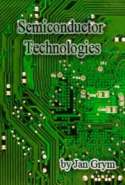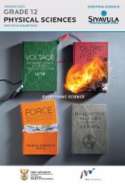Semiconductor Technologies
SEMICONDUCTOR PROCESSES AND DEVICES MODELLINGelectrons occupying orbits well defined Another example is the description of the driftrespectively the electrons and holes, moving under the influence of electric field In this casinto a set of equations or computing operations,a quantitative model Finally theting thequantitative model must be found and comparederimental data to ensure that thetes the phenephysical models often take the form of equations with partial derivatives, Partial DifferentialEquations-PDESimulation of micro/ nanoelectronics devices and processes equations requires theevaluation model,puting operations, niputprobability of the first experimeg process, ie finding thecombination ofconditions for that we have the smallest results at the changing of the prodThus, circuit simulating behaviour modification based on conditions changing ofentity the process tolerancesn general, semiconductor devices can be simulated more precisely as the manufactcircuits is still not well underst on, several physicalmanufacturingely on the empirical mod4 Empirical models4
1 IntroductioThe empirical models are only representations of experimental data and have a littlenothing physical background Experimental data are used to create an empirical modelExperimental results are stored in a database in the computer but are not providedused a mathematical functihich is adjusted by experimental dTo adjust the experimental data can use the next methodsolynomial function tothrough all points, leading to very compphically representedwhich don't passes through all points and which can be adjustedular method of adjustment is the method of leastrespectively theinimal sum of squares differences between points and the curve If a data set match onght line y=a+bx, the process of finding the coefficients a and b, known as regressioncoefficients, is called linear regression, If it adopts a non-linear functional approximation, isn to find the regression coefficients42 Empirical modecal models are used to simulate semiconddon't have other optin the physical background is not yet known
Semiconductor TechnIf incorporated as part of a program for simulation of a process or device, empiricalThe simulation results for these models is fast and directaccurate simulations for some particularthe simulated conditions are between the experimental data, the interpolation resultsbe found withthese models, this major limitation makes it impossible to extrapolate to conditions oulerimented fieldSemiempirical models are the models in which phendodellebased on physical parameters corresponding to these phenomena Most models used inlicon oxidation in dry oxygen, at thickness of less than 350a does not correspond DeaGrove model Nicollian and Rted a model for thistox=a(計+p)withb=constant, t=time of growth and t=time required to raise an initial layer thickness x Othercample is the boron implantation effects arising from sewage, ie penetration of boroneeper than mdelling this effect, an exponential portiadded to Pearson IV model The length of the falling exponential part is determinedempirically to the value of 450A
This empirical model is avail5 Designof the circuit from the design phase The problem arises is that every attempt to obtain ameters, is hit by hindertical model thatused effectively in dSuch as particularly important are the following aspects:set of factors aChoosing the set of respthat characterize the best performance expected from theThe problem is usually solved iterative following the overlapping findings resulting fromdfactorshat the founding rehave a high degree of confAlso, thesensitivity of the responses, given by the statistical nature of the technologicaldesired response Thus, by using based models simulation, can identify thethat allow the attainment of targets More precisely, starting from theles suchthetemperature, time,doselantation may control the thres1O5 transistors, parameter which influences the shape of the IV characteristics and sothe device parameters used in the circuit simulation and finally influencesparallel with extraction ofinformation useful to designers In this respectdistinguish the following stages of analys
SEMICONDUCTOR PROCESSES AND DEVICES MODELLINGset of factors that are considered to be sufficient for analysing theparameters of the requisite responses; the cha nominalue for each factor consideredaceptable in terms of tolerance of the technological processDefining a matrix corresponding with the doe strategy selectedts and collecting the results fel and analysis the conclusions from that studThe revaluatf the set factors and the strategy of experimentationObtaining the final response surface modelDesign of experiments is the key point of the optimisation process dnts are used to generate the Response Surface Model-RSM Are taken into aceinear models, where the responses are linear functions of factorsodels of order two for higre obtained as functions ofparabolic factors; these models constitute the standard in RSM techniTranscendental models for higher order design, which provides improved techniquesLinear models assume thaonse R is a linear combination of factors fi, fi,
fn WhenThe experimentsstar These are easily designed andThe square models guess that the response Ri is a square combination of input factors withtwo power grade of the factors and products of factors In this way is take into account thefactorial type and fractional-factorial type, Full-factorial strategies take intoration alpossible combinations of factors This approach providest fully change to full-factorial analysehe transcendental models assume the existence of a mechanism for transforminset of factorsmodified set used for rsmhe data obtained by experiments and those obtained by simulation are used to build aRSM, from which analysis may conclude a set of information aboutarious factors importance in the evolution of a responseSensitivities of respthe effect of a faple, for thef MOSFET technology flow the threshold voltage VT is thenput datahe following factors: oxide thickness TOX, Nsubntration of substrate, the peak concentration of channel implant for threshold voltage
Semiconductor Technologiesdjustment VTPEAK, the peak concentrations of LDD source and drain NLDDpeakdistance between the winof theand drainswTP∈Athat determines the threshold voltage of mosfet likethe MOS oxide thickness and the implantation dose for threshold adjustment, fig 17 Process optimisation71 IntroTCAD software packages first need equipment models using configuration and settings asput parameters in order to obtain the process environment and process model to createthe wafer data characteristics
Next using TCAD process simulator obtains the wafer statend using TCAd device simulator obtain device performance and the input data for circuplement the accurate atomic scale reaction models respectively reaction energies, rates,ducts and process equipment models respectively gas flows, reactant concentrations andIn the state of the art devices small geometry effects including hot electron transport, punchbreakdowneffects and discrete doping elements effects are ofdrick, 2008) Devices are also starting to exhibit significant quantumeffects including gate oxide and bandgap tunnelling, inversion layer quantization, quantumtransport and carrier density smoothing2 Optinameterctorsetting such that a number of relevant results meet predefined targets This problem islved using the concepts of statistical Design of Experiments-DOE, for planning a numberthings of input factorsThe simulation of process, device and cirespecific values for input factors for which the simulatining The results of
SEMICONDUCTOR PROCESSES AND DEVICES MODELLINGperiments are analysed for each of the responses as a function of the input factors and weminimum number of experiments we obtain a maximum information respectively detectioneffects, factor interaction effectswhich factorportant The rsM models are used to find factor settings that produce devices withsired specifications( Govoreanu, 2002)example referpe MOSFET realized in O,5um technology usingTaurus-workbench software package from Synopsys We start with substrate <100> boronoped at 5x1018 Then epitaxial growth of 6um silicon layer, 0, 2um oxide layer and 0, 15umtride and in the last two laely configured ISLAL and NWELL andOxia phorus is implanted with 2x1012 dose and 300Ke V energy After nitride removing andmplant with boron and PUNCH implant with boron at 5x10n1 dose and 50KeV energn, the polysilicon gateposited configuredphosphorus at 5x1015 doergy After NLDD imple anThe next process steps perform the contact and interconnection between devices and thection layfermp 2TN_ Dose pose E+13 LOE+13 1
0E+12 10E+12PNCH Dose pose BE+11 5 0E+11 5OE+11 50E+llNLDD_ Dose2 RSM-VHRK versus NLDD, VTn Table 1 The samples parametersUsing DOE and RSM techniques the most sensitive process stepsespectively Ve adjusting implant and NLDD implant These two parameters were modifieThe RSM results indicate a high dependence of breakdovtage functionmplant dose and a strong decreasing around 5x1012 VIN implant dose(figf threshold voltage versus PUNCH implant dose and a small doIterationnd 8x1012 VIN implant dose
Semiconductor TechnologiesThe increase of Nlddose at Sample 2 and 4 reduces the polysilicon depletioneffect, by reducing thedrop across the polysilicon gate and improving theansconductance(the higher slope of transfer characteristics for Sample 2 and 4), fig 7FiNet Doping SamplFig 4 Electron Injection Current Sample 2Table 1 and fig 3 to 6 the breakdown voltage is proportionally with the radiusVTn boron adjunction(Kwong, 2002 )
Output resistance is reduced by decreasing theg implant dose ( Sample 3 and 4)centration in the channel, which allows a shorter pinchoff region A shorterpinchoff region gives rise to a much larger magnitude of the Early voltageThe decrease of NLDd dose in Sample 3, fig 5, comwith Sample 2 fig, 4 move theelectron injection current from gate oxide to spaceroxide breakdofour samples the transfer characteristics are presented in fig 7 and the externalcharacteristics in fig 8(Campian, 2003)
SEMICONDUCTOR PROCESSES AND DEVICES MODELLING4Fig 7 ID-Vcs CharacterFig 8 Ip-Vos CharacteristicsIncreasing of lateral/drain slope lowers also the series resistance,t, but for very abrupt profile junction the impLion in leakage current due to more seshort channel effects8
MOSFET DC modefor distorti8 1 Intution of semiconductor devices will ultimately attend fundamenlimits as transistor reach the nanoscale aria In this context the MOSFET models must givariations and the relevant characteristics like current, conductanceflicker thermal or high free and distor(Scholten, 2009) The df linear analoglacks models for state-of-the-artlos transistors tby themodelling of the second order effects induced by high vertical gate field such as mobilitydegradation and series resistance and second order effects induced by parallel drain fieldke velocity saturation in the ohmic region, channel length modulation, static feedbaak avalanche and selfheating in the saturation region After a rigorous description ofinductance in ohmic and saturateincluded these effehe MOSFET model, using a compact drain current expression fortimehe channel mobility must beuantum-mechanically bethe thickness of theersion laver is in the orderA, smaller than the De Broglie wavelength of thecalculations show that energy subbands of electrons andthe normal electric field Ex, In the weak inversion region where many subbands areed, quantum effects can be neglected, but in the strong inversion where onl

In-TehAbstracting and non-profit use of the material is permitted with credit to thee statements anduthor or editor, and the make other personal use of the work
8 2010 In-tehFirst published April 2010Technical Editor: Sonja Mujacicsemiconductor Technologies,Edited by Jan GrymlsBN98-953-307080
PrefaceSemiconductor technoterials, new structures,ufacturing tools, and new advancements inbreeding ground for novel high performance electronic and photonic devices This bookand devices, including their modelling, design, integration, and manufacturingHigh costs, lond enormous increase in computingbehind a recent rapid progress of the modelling, simulation, optimisation, and design ofters present the state-of-the-artsemiconductor processes and deSeveral examples are given: simulation of the switchingharacteristics of SiC GTO, MOSFET DC modelling for distortion analysis, or high-k dielectricimpose new requirements on semiconductor manufacturing Semiconductor manufacturingbelongs to the most challenging and complicated production systems involving huge capitalvestment and cutting-edge technologies Chapter 3 discusses automation and integratiooted to the contaminationnd analysis Chapter 5plasma processing techniques and their emergingplications of etching, depith oxidation techniqmpounds and theirapplication in MOS-based structures and gas sensms mainly from its wide and direct energy bandgap, thermal and chemicghelectron drift velocity
Chapter 8 is a comprehensive presentation of the GaN-based MOSdevices with the emphasis on the description of various deposition methods of the dielectricchapter 9, the authors address two novel concepts for a mid-to-high voltage powerh directly addressing the limitations of current IGBT and S] MOSFETtechnologies Chapter 10 is devoted to the study of the external optical feedback innanostructure-based semiconductor lasers In chapter 11, the authors investigate the influenceof the electron transport on the optical properties of quantum-cascade structuresChapter 12 is dedicated to the preonductive oxide based onminumdoped ZnO for solar cells Chapter 13 summarizes the preparation of high puri
evice engineering method to provide high functionalitynlinear vertical-cavitydevices exploiting saturable absorption in semiconductor5,15 is a siof the stateof-the-art of all-optical flip-flops basedductor technologies, Chapterthe current development of optical detection technologies onlatform In chapter 17, the authors describe the design, fabrication technology, and devicepolitically integptical amplifier
In chapter 18, the authors propose a new approach to ultra-fast all-opticalal processing based on quantum dot devices Chapter 19 discusses present status anduture direction of all-optical digital processing through semiconductor optical amplifiersFinally, chapter 20 presents a new approach to biomedical monitoring and analysis of selectedhumanrym
ContentsSEMICONDUCTOR PROCESSES AND DEVICES MODELLING2 Iterative Solution Method in Semiconductor EquationsNorainon mohamed, Muhamad zahim sujod and mohamad shawal Jad3 Automation and Integration in Semiconductor ManufacturingDa- Yin liao4 Contamination monitoring and analysis in semiconductor manufacturingBaltzinger Jean-Luc and Delahaye BrunoMichael Shearn, Xiankai Sun, M David Henry, Amnon Yariv and Axel Scherer6
Wet thermal oxidation of gaAs and GaN7 Selective Oxidation on High-Indium-Content InAlAs/In GaAsMetamorphic High-Electron-Mobility Transistors8 GaN-based metal-oxide-semiconductor devicesChing-Ting LeeSemiconductor Devices UsingNovel Nano Structure for Low Lossesand Haldar Pradee0 The Critical Feed backanostructure-Based Semiconductor Laserslectron transport effect on optical response of quantum-casca253ykhailo Klymenko, Oleksiy Shulika and igor Sukhoivanov
Tvarozek, Pavol Sutta, Sona Flickyngerov3 Role of rare-earth elements in the technology of lll-V semiconductorsrepared by liquid phase epitaxyan Grym, Olga Prochazkova, Jiri Zavadil and Karel Dansksed nonlinear vertical-cavitysemiconductor devices for all-optical signal processingClaudio Porzi, Mircea Guina, Nicola Calabretta, Antonella Bogoni and5, All-optical flip-flops basedmiconductor technologiesAntonella Bogoni, Gianluca Berrettini, Paolo Ghelfi, Antonio MalacameGianluca Meloni, Luca Poti and Jing Wangm Photodetector Technologies for Opticalion in InP Mach-Zehnder Modulator Monolithically8 New Approach to Ultra-Fast All-Optical Signal Processing Basedon Quantum Dot devicesEzra
B Lembrikov9processing through semiconductor optical amplifiersntonella Bogoni, Emma Lazzer, Gianluca Meloni,ca poti and mirco scaffa20 Electro-Optical Monitoring and Analysis of Human Cognitive ProcePetra Solankova and vladimir Tvarozek
SEMICONDUCTOR PROCESSESAND DEVICES MODELLINGFlorin babaraFaculty of Electronics Telecommunications and Information Technologyuniversity Politehnica of Bucharest, Romania1 Introductionent of knowledgeis strongly influenced brComputer Aided Design-TCAD Here is an interesting positive feedbackputing power helps the designers to perform modelling, simulatiand design of the new devices with improved performance, which have thethe computing power The chapter present thestate-of-the-art of processesdevices modelling completed with the new aspectspresented by the author in their last few years papers like the results of his researches2 Models in micro and nanoelectronicsply TCAD is the foundation of/nanoelectronics rapidly progress
The analysis involves the separation of the entire in component parts, characterization anddement them and also the examination of the elements of system and the relationsbetween them to understandSimulation is the imitative representhe operation of other's or the examination of a problem without experimentation If theacceptModelling is the production of a representation or simulation of a problem, process ordevice, making a description or analogies to help the visualization of the aspects that can'tbe directly observed Modelling is a need for analysis, simulation and design optimiualitatinpler than a model for analysis, which should reflect the physical aspehplication of Monte Carlo method, which isequivalent to producing an imitative representation of the system functioning We mustprevious experiments and simuli application of the model Also musta aive the obtainedalways know the limitations of a model in order to don't interpret toresults only through the improperperience from
Semiconductor TechnologiesDevelopment of electronic devices involves many tests and scraps for manufacturing untilrformed Impldevice models, simulation and analysis, can now and in the future, to decrease substantiallrough estimation of thsaved by analysis and simulation is of the order of 40% This percentage depends heavi&the conditions of each individual project The complete elimination of the tests and scrapspossible today due to the uncertainty of many parameters of the modelsavailable that are already very sophiespecially thehich the quantum mechanical aspecdecreased cost ofthe cost of experimenumerical modelling of the devices becomes more important for miniaturizedfor which only large modelsprediction and analysis of device p22 Technological modelshe technological model is a schematic or analog description of the phenomenon or systemhat matter for his knotproperties and coulused to the furthermodels that mean the modelled phenunknowIn thisterminedQuantitative empirical model in this caseexon that fitsPhysical models can produce explanations or views of the phenomenondevicestudied even the studied effect is not directly observablePhysical and empirical models serve as vehicles for processes or devices studied; certainspects of real devices or processes can be examined by studying the characteristics orthe respectively mhough the simulationredhe test time andstable and optimised pOften, a simulation allodying windoto help optimise the device structure by setting theditions
The biggestndf advancednductor de3 Physical models developmentThe development of physical models is generally in the following stages:Making the model qualitativeMaking the model quantitatiing qualityhece of the phenomenon observethis fthe moderealize theevices studied This is particularly important inmicroelectronng investigated are notbservable An example is the description of the Bohr atom model, the nuclei surrounded by
-
Latest
 Physical Sciences
Physical SciencesPRACTISE INTELLIGENTLYPRACTISE FOR TESTS EXAMs online ON yOUR PHoNEsts and exams you need practibut knowing where to start and getting pastEffect of mass on gravitational forcepapers can be difficultn...
-
Next
 12 Social Media Hacks That Work Growth Hacker Granny
12 Social Media Hacks That Work Growth Hacker Granny12 SOCIAL MEDIAHACKS THAT WORKGROWTH HACKERGRANNYN GRANNY REVEALS IT ALLSRINIDHI RANGANATHANTHE CTA ON ANY LINK HACKDetails of the hackeacor your own advertisements on anyarticle or video that you fin...
Popular Articles
- Semiconductor Technologies
- Netflix’s next interactive show is Headspace's Mindfulness Experience
- Learn American Sign Language with 21 highly rated courses
- Keystone Light becomes a must-have wearable device in summer
- Ford received a pre-order for 100,000 F-150 Lightning in three weeks
- HASC to scrutinize Space Force budget: Satellites have to be ‘easier to defend’
